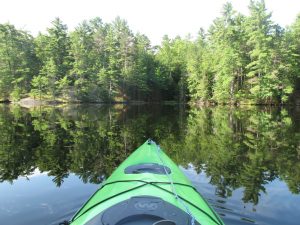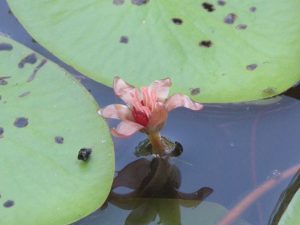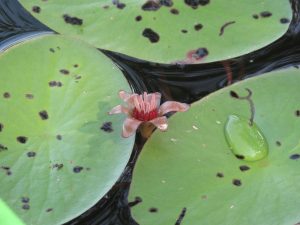 This morning the lake resembled a sheet of glass ~ or more like a mirror with the perfect reflection of the long needled pine trees, the various selection of docks and the unique rock formations native to the Severn waterways. Perfect for a kayak ride. So, with my paddle in hand, I headed out for a morning journey through the channel ~ swiftly at times, concentrating on the angle of the paddle and the rhythmic shifting from side to side and slowly at other times enjoying the beauty of the view that one can only truly appreciate from being directly on the water.
This morning the lake resembled a sheet of glass ~ or more like a mirror with the perfect reflection of the long needled pine trees, the various selection of docks and the unique rock formations native to the Severn waterways. Perfect for a kayak ride. So, with my paddle in hand, I headed out for a morning journey through the channel ~ swiftly at times, concentrating on the angle of the paddle and the rhythmic shifting from side to side and slowly at other times enjoying the beauty of the view that one can only truly appreciate from being directly on the water.
I had brought my camera for those “just in case” moments and the stillness of the water afforded me the opportunity to capture a few shots, without the fear of tipping.
Two hours later, as I neared the cottage, and started to brace myself for the docking procedure (still my least favourite part of the kayaking experience), I decided to loop to the other side of the peninsula and check out our one white water lily. I’m not sure why we only have one lily ~ there is a multitude of lily pads ~ but just one lone lily. None the less, the conditions were perfect for a water level picture of the lily so onward I ventured.
In order to get to the lone lily, I needed to paddle through what I had always thought of as a layer of just leaves. Most of the leaves had various brown spots, making them look as if they were diseased in some way. These leaves cover most of the surface area within our little bay and to be honest I hadn’t given them much thought. But as I slowed down and angled the kayak towards the lonely lily, I noticed something popping up beside one of the “diseased” leaves. As I got closer, I saw a beautiful, delicate and intricate red flower. Upon further investigation it became apparent that the whole bay was filled with a sea of these flowers ~ flowers that were unnoticeable from the shoreline. With the help of the zoom feature on the camera, it quickly became apparent that the little red flowers were even more striking than the single white lily which was my initial quest.
 Later that night, as I reviewed the pictures on my camera, I couldn’t help but wonder if we, as educators, sometimes miss the beauty of the smaller more notable things on our quest for the big significant things. How many small red flowers do we miss in our quest for the white lilies?
Later that night, as I reviewed the pictures on my camera, I couldn’t help but wonder if we, as educators, sometimes miss the beauty of the smaller more notable things on our quest for the big significant things. How many small red flowers do we miss in our quest for the white lilies?
Have we become so focused on the big picture prizes ~ such as EQAO ~ that we’ve forgotten to get in the water and notice the multitude of smaller, more notable, more delicate and more bountiful prizes. Those day to day examples of learning, curiosity, questions and “aha” moments need to be experienced while we are in the “water” with our students.
Anyone can see the white lilies from the shoreline. You can count them and even predict when they will be in full bloom and when they will close for the evening and rest. But if we truly want to understand the landscape ~ or in this case the ecosystem of the bay ~ then we can’t stay on the shore. And just like truly taking part in student learning, we need to get in the water (which includes the excitement and sometimes fear of the launch and the docking) and look beyond the “diseased” leaves to experience the beauty.
What have you been pleasantly surprised by, when you “got into the water” and learned alongside of your students?
 Come write with me….
Come write with me….

First of all, Sue, what beautiful imagery! It’s amazing how nature can cause us to reflect and re-evaluate, and the joyful gifts it can provide when we are open to seeing them. I’d like to address your question: “What have you been pleasantly surprised by, when you ‘got into the water’ and learned alongside of your students?”
My first year teaching was in a Grade 1 LTO. I had a student who I’ll call “Andy”. He was what might be called a “handful and a half”. About three weeks in, after many calls to the office for assistance, two parent meetings, one suspension, and two parents demanding that either their children or Andy be removed from my class, I was at my wit’s end. Then, I tried something radical – I tried listening to him. At first this often amounted to ten-minute sessions of Andy spewing defensive self-justifications, curse words, and “I hate school!” type statements. But I kept my frustration in check, forced myself to stop worrying about the time I was taking away from “the important stuff” like curriculum, and just listened; asking questions to be sure I understood, and reflecting his feelings back to him. My small-red-flower moment came when I was paged to the office during lunch hour and found Andy sitting in a chair, red-faced and tight-fisted, looking like he was ready to explode. That wasn’t unusual – what was, is that there had been no incident of inappropriate behaviour in the school yard and it wasn’t a teacher who sent Andy to the office. He got angry with another student and ran to the office and told the secretary he needed to talk to me. Instead of lashing out, he chose to find someone who would listen to him. Over the next weeks and months, I learned a lot about Andy – his interests, what made him laugh, what made him sad or anxious, and what made him feel happy and successful. Watching him learn how to deal with conflicts, communicate his needs, and make friends … in other words, watching him enjoy being at school, was incredibly gratifying. Andy taught me that making the effort to let a student know that he is cared about and valued is a teacher’s greatest responsibility and greatest joy. He made me a better teacher.
Very well said Susan! I have frequently been pleasantly surprised by the willingness of students to take a risk, put themselves out there and ask amazing questions when we build in opportunity for this to unfold. The big data while providing useful information cannot possibly capture the thinking, emotion, sharing, joy and inspiration of being witness to a moment of risk taking and profound questioning for learning.
We understand much more when we give this consideration and honour it by taking time to make note of it.